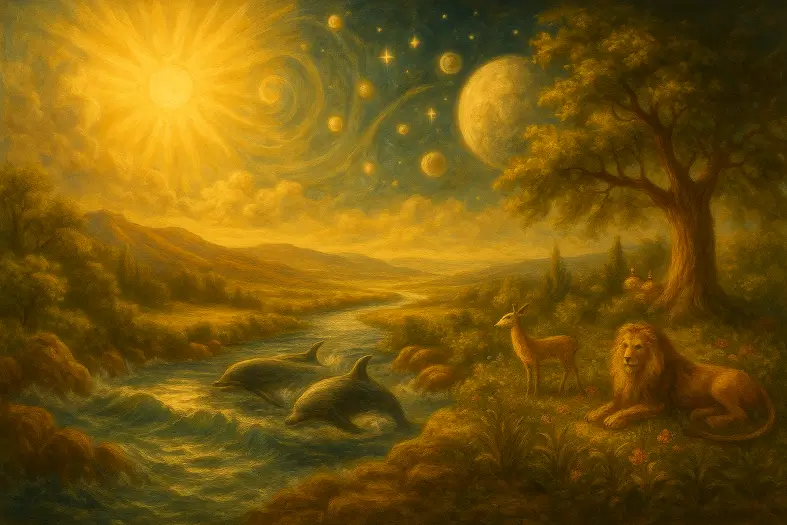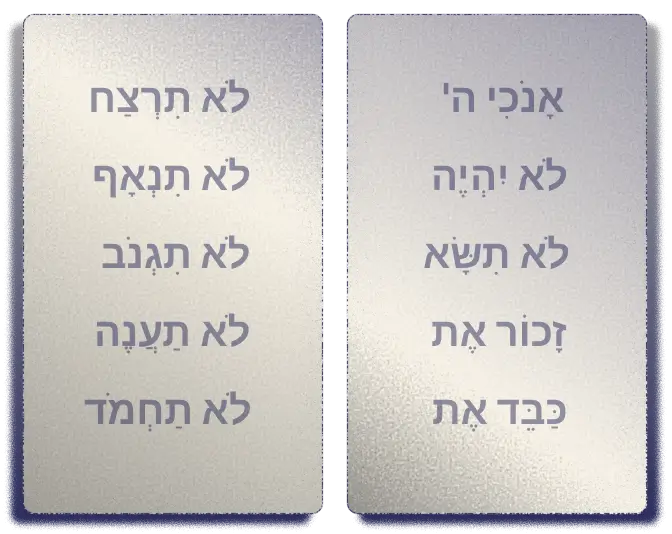



In the opening of the Torah, HaKadosh Baruch Hu brings forth Ma’aseh Bereishit (Creation), forming the heavens, the earth, and all that fills them in six days, and sanctifying the seventh as Yom HaShabbat —the day of Divine rest. Adam HaRishon and Chavah dwell in Gan Eden, charged to guard and elevate it, yet they partake of the Eitz HaDa’at Tov VaRa (Tree of Knowledge of Good and Evil) and are sent forth from the Garden to live by the sweat of their brow. Their sons, Kayin and Hevel, bring korbanot (offerings) before Hashem, but jealousy leads Kayin to spill his brother’s blood and to bear the mark of Divine justice. The Parsha concludes with the lineage from Adam to Noach, ten generations through which mankind descends from purity to corruption—setting the stage for the great mabul (Flood) in the days of Noach.








Rashi:
Rashi opens the Torah with a question: Why does the Torah begin with creation instead of the first mitzvah? He answers that the account of Bereshit teaches a moral foundation before a legal one — establishing that G-d, as Creator, is the rightful sovereign over the world. This validates Israel’s inheritance of the Land, for “He told His people the power of His works, to give them the heritage of nations.” (Tehillim 111:6)
Creation, in Rashi’s view, is not only history — it’s a declaration of divine ownership and moral order. Every act of creation carries ethical weight: a world built by G-d demands justice and gratitude from its inhabitants.
📖 Sources:
Rambam teaches that the opening of Bereshit — “In the beginning, G-d created the heavens and the earth” — establishes the principle of Creation Ex Nihilo (yesh me’ayin): the universe was brought into existence by G-d’s will, not from pre-existent matter.
He rejects Aristotle’s idea of an eternal universe, emphasizing that time itself began with creation — there was no “before.”
📖 Sources:
In Guide for the Perplexed (II:30), Rambam explains that the “days” of creation are conceptual stages, not literal 24-hour intervals — describing the order and hierarchy of existence rather than a chronological process.
The narrative conveys metaphysical truths:
📖 Sources:
When the Torah states that humanity was created “in the image of G-d,” Rambam interprets this as the gift of intellect and moral reasoning, not physical resemblance.
Human beings are distinguished by the capacity to know G-d, to choose, and to act ethically. That rational soul is our divine “image.”
📖 Sources:
The sin of Adam and Chava, in Rambam’s view, was not a primitive act of eating fruit but a shift in consciousness — from pure intellect (truth vs. falsehood) to sensory, subjective good and evil.
Before sin, they operated on objective truth; afterward, they judged by desire vs. aversion, introducing moral struggle and human frailty.
Thus, the story illustrates free will, moral awareness, and responsibility as the essence of humanity.
📖 Sources:
Rambam holds that the serpent and the dialogue are allegorical depictions of internal human forces — temptation, imagination, and moral reasoning — rather than literal talking beings.
He cautions that the “Ma’aseh Bereshit” (Work of Creation) and “Ma’aseh Merkavah” (Work of the Chariot) are esoteric subjects, suited only for mature, trained minds ready for abstract contemplation.
📖 Sources:
Ultimately, Rambam sees the purpose of creation as the realization of knowledge of G-d and ethical perfection.
Human intellect, when used to contemplate the Creator and act righteously, fulfills the design of existence itself.
To know G-d is to love Him through understanding — and to imitate His ways through moral virtue.
📖 Sources:
Rambam’s Bereshit is less about how the world was made and more about why it exists:
“To know the Creator, to love Him through understanding, and to imitate His ways through moral virtue.”
📖 Key Reference:
Sefer HaChinuch (Mitzvah 32):
The Sefer HaChinuch identifies Shabbat, first introduced in this parsha, as a weekly testimony to creation. Observing Shabbat affirms that the world is not self-existent — that G-d actively renews creation. Through rest, reflection, and holiness, a Jew internalizes faith in divine providence and purposeful design.
In his words, Shabbat was given “to fix in our souls belief in the renewal of the world,” cultivating gratitude and humility before the Creator who continues to sustain all existence.
📖 Source:
Or HaChaim:
The Or HaChaim reads Bereshit bara Elokim (“In the beginning G-d created”) as “For the sake of reishit,” meaning “for the sake of Torah and Israel,” both called reishit. The purpose of creation is the revelation of divine light through those who study Torah and fulfill mitzvot.
He teaches that every soul has a share in this cosmic purpose — the world exists to allow the righteous to draw holiness into physical reality, transforming creation into a dwelling for the Divine.
📖 Source:
Sfas Emes (Bereshit 5643):
The Sfas Emes reveals a dynamic interpretation of creation: “Each person’s Bereshit begins anew every day.” Just as G-d renews the universe continually, the soul experiences renewal whenever it chooses light over darkness, order over chaos.
This inner creation mirrors the cosmic one — each act of moral clarity and spiritual effort is a re-enactment of the first “Let there be light.” Creation, then, is not an event in the past but an ongoing dialogue between G-d and humanity.
📖 Source:
Rabbi Jonathan Sacks zt"l:
Rabbi Sacks sees Bereshit as the foundation of Jewish moral vision. Humanity is created b’tzelem Elokim — in G-d’s image — conferring dignity, freedom, and responsibility on every person. Creation is thus a call to partnership: to build, cultivate, and protect the world.
He writes, “The first moral truth of Judaism is that life has purpose and meaning. We are not accidents of matter, but reflections of a divine image.” This transforms the act of creation into the birth of human ethics itself.
📖 Source:
Rav Avraham Yitzchak HaKohen Kook:
Rav Kook expands the idea of creation beyond a moment in time — it is a continuous process, a divine melody echoing through history. Each generation, and each individual, adds new notes to this song of renewal.
He writes that our mission is to “elevate the material toward the spiritual,” seeing progress, creativity, and compassion as forms of divine revelation. Through art, thought, and holiness, we participate in the Creator’s ongoing work of perfecting the world.
📖 Source:
Bereshit is more than the world’s beginning — it’s the invitation to begin again.
Each day we are called to create — to bring order to confusion, light to darkness, and purpose to the mundane. Just as G-d “separated” light from darkness, we must cultivate discernment — choosing kindness over cruelty, truth over falsehood, sanctity over self-interest.
Every mitzvah, every moment of mindfulness, is a small ma’aseh bereshit — an act of creation that restores harmony and meaning to the world.
📖 Supporting Sources:


Rashi opens the Torah with a classic question:
“The Torah should have begun with ‘This month shall be for you…’ (Exodus 12:2), the first commandment given to Israel!”
He answers that Bereshit begins with creation to establish G-d’s sovereignty:
“He told His people the power of His works, to give them the heritage of nations.” (Psalms 111:6)
By showing that G-d created and rules the world, the Torah justifies Israel’s divine inheritance of the Land. This sets a moral and theological foundation: creation proves ownership, and ownership establishes divine justice.
📖 Sources:
Rashi interprets Bereshit not as a simple chronological opening but as a conditional clause—“When G-d began to create…”—showing that the verse introduces process, not sequence.
He insists the Torah isn’t giving a physics lesson but a spiritual narrative of divine purpose: light, order, and goodness emerging from chaos.
Every phrase reflects moral creation—each boundary, distinction, or separation expresses Divine will bringing harmony to potential disorder.
📖 Source:
On “Let there be light,” Rashi explains this isn’t sunlight (created later) but spiritual light—a primordial illumination reserved for the righteous in the World to Come.
This divine light symbolizes truth, wisdom, and moral clarity—a perfection too pure for the present world.
It reveals G-d’s attribute of Chesed – benevolent creation, giving good even before there is anyone to receive it.
📖 Source:
Rashi focuses on the plural “Let us make.” He teaches that G-d consulted His heavenly court—angels—before creating man, to model humility and consultation.
Though this wording could invite heretical misunderstanding, the Torah teaches that truth is not compromised to protect against error when the lesson is moral greatness.
G-d shows deference to His servants to demonstrate the value of collaboration and respect, even from the Highest to the lesser.
📖 Source:
Rashi explains that man and woman were created as a single being—back-to-back—and later separated so that they could face one another in partnership.
This symbolizes that relationship is not hierarchy but unity through difference: man and woman mirror G-d’s dual attributes of justice and mercy.
Creation of woman “from man” is an act of refinement, forming companionship and harmony rather than dominance.
📖 Sources:
Rashi interprets the verse “to work it and to guard it” as both spiritual and physical stewardship.
Adam was placed in Eden not merely to enjoy pleasure but to engage in moral cultivation—performing mitzvot (“to work it”) and guarding against sin (“to guard it”).
The Garden thus becomes the model for human life: paradise depends on obedience, gratitude, and purpose.
Sin, for Rashi, is not eating fruit but disregarding divine boundaries that preserve order and goodness.
📖 Sources:
Rashi notes that the serpent was endowed with intellect and speech before the curse.
Its cunning words represent how temptation begins not in appetite but in distortion of truth.
By contradicting G-d’s word—“You shall not surely die”—the serpent introduced doubt, the root of moral collapse.
Evil, therefore, enters through the misuse of divine gifts—language, reason, and persuasion.
📖 Sources:
Rashi reads G-d’s judgments on Adam and Chava not as vengeance but as educational consequence.
Suffering refines character, labor redeems purpose, and childbirth pain sanctifies continuity.
Even exile contains mercy: G-d clothes them before banishing them, showing that compassion accompanies justice.
Humanity leaves Eden not cursed, but called to rise through effort and repentance.
📖 Sources:
Rashi teaches that the world was not complete until the creation of rest—the final element that brought harmony to existence.
“What was the world lacking? Rest. When Shabbat came, rest came, and thus creation was complete.”
Shabbat is the divine seal on creation, revealing that true perfection is spiritual peace—ceasing creative activity to recognize the Creator.
Through Shabbat, humanity participates in the rhythm of divine order and acknowledges that all labor serves a higher rest.
📖 Source:
Rashi’s Bereshit weaves theology and ethics into every verse.
Creation is not a scientific chronicle but a moral drama:
“The Torah begins with creation,” teaches Rashi, “to show that the world itself was made for justice and compassion — that G-d’s goodness fills the beginning of all things.”
📖 Key Reference:


Ramban:
The Ramban deepens this by introducing the concept of yesh me’ayin — creation from absolute nothingness. He writes that the Torah’s first verse alludes to a primal act beyond human comprehension: G-d’s will brought form and matter into existence, then shaped them with perfect balance and purpose. The process reveals divine wisdom hidden within nature.
To Ramban, creation is a continuous act — the natural order is sustained only through G-d’s constant will. The visible universe is a mirror of the spiritual, teaching that faith and intellect meet in recognizing G-d’s ongoing presence in every detail of existence.
📖 Source:


Sforno opens Bereshit by asserting that G-d created the universe for the sake of humanity’s perfection — not for G-d’s need, but so that human beings could recognize His goodness and emulate it. Creation is an act of divine benevolence, aimed at enabling conscious beings to attain eternal life through moral and spiritual refinement.
“In the beginning, G-d created…” — Sforno explains that bereshit indicates purposeful design: G-d began creation with the end goal of producing beings capable of perceiving Him.
📖 Sources:
When G-d says, “Let there be light,” Sforno interprets it not only as physical illumination but as intellectual and spiritual enlightenment — the first manifestation of divine wisdom within creation.
This “light” represents the radiance of divine awareness that allows man to understand G-d’s handiwork and align with His will. It is the root of all truth and moral order.
📖 Source:
Sforno emphasizes that creation unfolds through deliberate order, progressing from potential to perfection. Each day refines existence toward harmony — separating, distinguishing, and assigning each part its unique function.
He notes that the refrain “And G-d saw that it was good” signifies not aesthetic beauty but functional goodness — everything performing in accordance with divine purpose.
📖 Sources:
When G-d declares, “Let us make man in Our image,” Sforno defines tzelem Elokim as human intellect and moral agency — the capacity to know truth and choose righteousness.
Unlike the animals, man is endowed with the ability to govern himself and creation through reason and free will. This, Sforno says, is humanity’s true likeness to G-d: the power to act with wisdom, compassion, and justice.
Man’s mission is not domination but stewardship — to perfect the world through conscious action and divine imitation.
📖 Sources:
Sforno reads the Garden of Eden as the ideal environment for human spiritual growth. Humanity was given both pleasure and purpose, with one command — to refrain from the Tree of Knowledge — as a test of obedience and wisdom.
The sin of Adam and Chava was not simply disobedience but a misuse of free will, seeking wisdom apart from G-d’s guidance. After the sin, humanity retained intellect but lost its original clarity, now perceiving good and evil through experience rather than divine intuition.
📖 Source:
After the fall, Sforno writes, G-d’s response is both justice and mercy. Humanity is exiled not as punishment alone but as an opportunity for redemption through labor and repentance.
By working the earth and enduring struggle, man can refine his soul and rediscover divine purpose. The physical world becomes the arena for spiritual restoration.
📖 Sources:
For Sforno, Shabbat represents the fulfillment of creation’s purpose — a state where everything returns to its proper balance and G-d’s perfection is reflected in human rest and contemplation.
By ceasing from labor, man acknowledges G-d as the ultimate Creator and mirrors His divine tranquility. Shabbat is thus the bridge between the physical and spiritual worlds, a foretaste of the eternal harmony intended from the beginning.
📖 Source:
Sforno’s Bereshit teaches that creation was not an accident or cosmic event but a moral project — G-d’s deliberate effort to craft a world in which humanity could know, love, and emulate Him.
“The goal of creation,” writes Sforno, “is that man should merit eternal life through the knowledge of his Creator and the perfection of his soul.”


Abarbanel opens with a profound question: Why begin the Torah with the story of creation instead of with the first mitzvah?
He answers that Bereshit reveals G-d’s absolute sovereignty. Creation is the foundation of all faith — demonstrating that G-d is the purposeful designer of existence and the continuous governor of the world.
Unlike Aristotle’s eternal universe or Rambam’s metaphysical abstraction, Abarbanel insists that creation was a temporal act of Divine will, expressing both G-d’s wisdom and goodness.
📖 Sources:
Abarbanel rejects the idea that Bereshit is a “dependent clause” (as Rashi suggests) and interprets it instead as a complete statement of creation’s beginning — “In the beginning, G-d created from nothing the heavens and the earth.”
He explains that Elokim emphasizes G-d’s role as Judge and Sustainer, introducing divine order and justice into the fabric of creation.
This verse encapsulates the totality of the universe — both the heavenly and the earthly realms — unified under one Divine Creator.
📖 Source:
Abarbanel meticulously analyzes each of the six days, viewing them as progressive stages of refinement.
Creation moves from chaos (tohu vavohu) to order, from potential to purpose. Each day reveals a deeper level of divine intent:
For Abarbanel, the six days describe not natural chronology but a teleological unfolding — a design moving toward the ultimate good of humankind.
📖 Sources:
Abarbanel interprets “Let us make man in Our image” as referring to man’s spiritual and intellectual likeness to G-d. Humanity reflects the Creator’s image through intellect, free will, and moral governance.
He emphasizes that dominion over creation does not mean exploitation but stewardship — humanity’s obligation to rule the world with justice and compassion.
In contrast to Rambam, who sees tzelem Elokim primarily as intellect, Abarbanel integrates intellect, morality, and physical form — the complete human being as a reflection of Divine harmony.
📖 Source:
Abarbanel sees the Garden of Eden as a moral laboratory — a perfect environment for testing humanity’s ability to balance desire and wisdom.
He asks: Why would G-d place temptation in paradise? His answer: to enable true free will. Without the Tree of Knowledge, there would be no moral development.
The serpent symbolizes the inner voice of desire, and the sin represents choosing pleasure over divine command.
The punishment is not vengeance but consequence — loss of innocence and the necessity of struggle for moral growth.
📖 Sources:
Following the sin, Abarbanel portrays exile as a transition from ideal to real — from effortless existence to toil and mortality.
He emphasizes that this exile was educational, not punitive: through work, pain, and time, humanity learns repentance, humility, and perseverance.
The expulsion from Eden marks the beginning of history — a new stage in humanity’s partnership with G-d to restore harmony to creation.
📖 Source:
For Abarbanel, Shabbat represents the goal of creation — a return to unity and spiritual peace.
The cessation of creation on the seventh day reflects G-d’s satisfaction with the harmony He established.
By resting, humanity imitates the Divine, affirming that the universe is complete and meaningful.
Shabbat is both commemoration and aspiration — a weekly restoration of the original Edenic order.
📖 Source:
Abarbanel’s Bereshit unites philosophy, theology, and ethics:
“Creation began with wisdom and ended with purpose — that man might know his Creator, perfect himself, and bring the world to peace.”
He transforms Bereshit into a manifesto for faith and moral responsibility — affirming that the story of beginnings is, above all, a call to elevate life through knowledge, justice, and Shabbat harmony.
📖 Key Reference:


Rabbi Miller opens with a central truth: “In the beginning, G-d created…” is not merely history — it is a proclamation of Divine ownership.
The world and everything within it belong to Him. Humanity’s mission is to serve as caretakers under His sovereignty.
Every moment of life, when lived with awareness of G-d, becomes a form of avodah (service) and kiddush Hashem (sanctification of His Name).
Sources:
When G-d declared “Let there be light,” the light was not only physical — it was spiritual illumination: wisdom, moral clarity, and the revelation of purpose.
Each act of separation — light from darkness, heaven from earth — mirrors the creation of moral boundaries in human life.
Rabbi Miller teaches that moral chaos arises when these G-d-given distinctions are blurred.
Sources:
The story of Adam and Chavah is, in Rabbi Miller’s view, the archetype of human choice.
Gan Eden represents harmony with the Divine order. The sin of eating from the Tree of Knowledge was not mere disobedience — it was replacing G-d’s will with self-will.
Exile from Eden thus becomes a lesson in moral consequence and spiritual education.
Through struggle, labor, and teshuvah (repentance), humanity re-discovers its purpose: to bring G-d into the world through obedience and gratitude.
Sources:
Rabbi Miller emphasizes that creation was not complete until the seventh day.
Shabbos reveals that menuchah (rest) is not idleness, but recognition of G-d’s sovereignty — a time to pause and acknowledge that all creation depends upon Him.
By ceasing work, one declares faith that G-d governs both sustenance and success.
Thus, Shabbos is the seal of creation, where mankind joins the Creator in harmony and peace.
Sources:
Rabbi Avigdor Miller’s Bereishis teaches that:
The Torah’s first words remind us that the universe is not self-made — it is a living testimony to G-d’s purpose, goodness, and presence in every moment of existence.

Dive into mitzvot, prayer, and Torah study—each section curated to help you learn, reflect, and live with intention. New insights are added regularly, creating an evolving space for spiritual growth.

Explore the 613 mitzvot and uncover the meaning behind each one. Discover practical ways to integrate them into your daily life with insights, sources, and guided reflection.

Learn the structure, depth, and spiritual intent behind Jewish prayer. Dive into morning blessings, Shema, Amidah, and more—with tools to enrich your daily connection.

Each week’s parsha offers timeless wisdom and modern relevance. Explore summaries, key themes, and mitzvah connections to deepen your understanding of the Torah cycle.